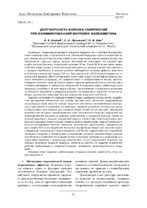| dc.contributor.author | Шалый, Е. Е. | |
| dc.contributor.author | Леонович, С. Н. | |
| dc.contributor.author | Ким, Л. В. | |
| dc.coverage.spatial | Йошкар-Ола | ru |
| dc.date.accessioned | 2024-09-02T08:34:25Z | |
| dc.date.available | 2024-09-02T08:34:25Z | |
| dc.date.issued | 2018 | |
| dc.identifier.citation | Шалый, Е. Е. Долговечность морских сооружений при комбинированной коррозии железобетона = Durability of marine structures at combined corrosion of concrete / Е. Е. Шалый, С. Н. Леонович, Л. В. Ким // Вестник Поволжского государственного технологического университета. Серия: Материалы. Конструкции. Технологии. – 2018. – № 1. – С. 65-72. | ru |
| dc.identifier.uri | https://rep.bntu.by/handle/data/148857 | |
| dc.description.abstract | Госпрограмма развития Северного морского пути и соответствующей портовой инфраструктуры в арктической зоне Российской Федерации сделали актуальной задачу повышения долговечности железобетонных сооружений, широко применяющихся при строительстве северных портов. Данные обследований показывают, что средний срок службы морских бетонных сооружений составляет 30 лет. Около 90 % из них имеют дефекты бетона в виде трещин и отколов и коррозии арматуры, которые снижают долговечность и несущую способность. В морских условиях наблюдаются основные дефекты защитного слоя бетона в начальный период 7-10 лет. При диагностике у 85 % отремонтированных сооружений в пределах 100 м от береговой линии снова через 5-10 лет зафиксированы признаки повторной деградации, что свидетельствует о неэффективности метода ремонта. Хлоридная агрессия - одна из главных причин коррозии арматуры бетонных конструкций, в основном шельфовых и прибрежных сооружений. Хлорид-ионы имеют наибольшую активирующую способность из всех видов анионов. Проникновение хлорид-ионов вследствие капиллярного всасывания и диффузии разрушает пассивирующую защитную пленку на арматуре, в результате происходит быстрое разрушение защитного слоя бетона. В данном исследовании усовершенствована модель диффузии хлорид-ионов и разработано программное обеспечение для анализа долговечности. Выполнено моделирование концентрации ионов хлора по глубине защитного слоя бетона железобетонной конструкции в зависимости от условий ее эксплуатации. Требуется разработка оптимальных ресурсосберегающих схем ремонта для снижения общей стоимости конструкций. Предложена вероятностная методика прогнозирования срока долговечности морских сооружений при комбинированной коррозии от действия карбонизации и хлоридной агрессии. Одним из условий надежности морских сооружений является соответствие свойств материала конструкций природно-климатическим условиям района строительства. Задачей экспериментальных исследований являлось получение качественных характеристик, определяющих срок службы бетонных сооружений. Выполнена верификация модели для решения задачи определения концентрации хлора в защитном слое бетона гидротехнических сооружений. Проведены натурные и лабораторные исследования состояния портовой инфраструктуры южной части острова Сахалин в городах Холмск и Корсаков. Сравнивалось содержание хлоридов возле арматуры с предельным содержанием, то есть содержанием хлоридов, при котором начинается коррозия арматуры. Выполнены расчеты по моделям совместного действия карбонизации и хлоридной агрессии, показавшие удовлетворительную сходимость. | ru |
| dc.language.iso | ru | ru |
| dc.publisher | Поволжский государственный технологический университет | ru |
| dc.title | Долговечность морских сооружений при комбинированной коррозии железобетона | ru |
| dc.title.alternative | Durability of marine structures at combined corrosion of concrete | ru |
| dc.type | Article | ru |
| local.description.annotation | The State program for the development of the Northern Sea Route and appropriate port infrastructure in the Arctic zone of the Russian Federation made the task of increasing the durability of reinforced concrete structures widely used in the construction of northern ports urgent. Survey data show that the average service life of marine concrete structures is 30 years. About 90 % of them have concrete defects in the form of cracks and spalling and corrosion of the reinforcement, which reduce the durability and bearing capacity. In sea conditions, the main defects of the protective layer of concrete are observed in the initial period of 7-10 years. In the diagnosis of 85 % of the repaired structures within 100 m of the shoreline again in 5-10 years, signs of repeated degradation are recorded, which indicates the ineffectiveness of the repair method. Chloride aggression is one of the main reasons for corrosion of reinforcement of concrete structures, mainly offshore and coastal structures. Chloride ions have the greatest activating ability from all kinds of anions. Penetration of chloride ions due to capillary suction and diffusion destroys the passivation protective film on the reinforcement, resulting in rapid destruction of the protective layer of concrete. In this study the model of diffusion of chloride ions has been improved and software has been developed for the analysis of longevity. Modeling of chlorine ion concentration on the depth of the protective layer of concrete reinforced concrete structure in accordance with the conditions of its operation is performed. It is required to develop optimal resource-saving repair schemes to reduce the overall cost of structures. A probabilistic technique for predicting the longevity of marine structures with combined corrosion from carbonization and chloride aggression is proposed. One of the conditions for the reliability of offshore structures is the correspondence of the properties of the material to the natural and climatic conditions of the construction area. The task of experimental studies was to obtain quality characteristics that determine the service life of concrete structures. The model was verified to solve the problem of determining the chlorine concentration in the protective layer of concrete in hydraulic structures. Natural and laboratory studies of the port infrastructure of the southern part of Sakhalin Island in the cities of Kholmsk and Korsakov were carried out. The chloride content near the reinforcement was compared with the limiting content, that is, the chloride content, at which the corrosion of the reinforcement begins. Calculations were carried out for the models of the combined effect of carbonization and chloride ingression, which showed satisfactory convergence. | ru |

